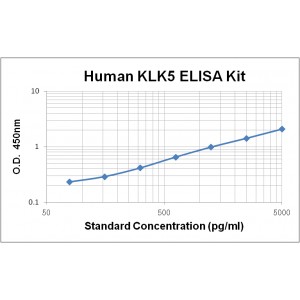More info
Assay Range | 78 - 5,000 pg/mL |
Sensitivity | 10.0 pg/mL |
Size | 96T |
Storage | Store at 2 - 8ºC. Keep reconstituted standard and detection Ab at -20 ºC |
Assay Principle | Sandwich ELISA |
Sample Volume | 100 µL final volume, dilution factor varies on samples |
Detection Method | Chromogenic |
Kit Components
1. Recombinant Human KLK5 standard: 2 vials
2. One 96-well plate coated with Human KLK5 Ab
3. Sample diluent buffer: 12 mL - 1
4. Detection antibody: 130 µL, dilution 1:100
5. Streptavidin-HRP: 130 µL, dilution 1:100
6. Antibody diluent buffer: 12 mL x1
7. Streptavidin-HRP diluent buffer: 12 mL x1
8. TMB developing agent: 10 mL x1
9. Stop solution: 10 mL x1
10. Washing solution (20x): 25 mL x1
Background
Kallikrein 5 (KLK5, hK5), also known as SCTE (stratum corneum tryptic enzyme), or Kallikrein-like protein 2 (KLK-L2), is a secreted glycoprotein belonging to the human tissue kallikrein family. KLK5 is a 293 amino acid (aa) precursor protein containing a signal peptide, a pro region and an enzyme domain. It is secreted as an inactive proprotein that is subsequently activated by proteolytic cleavage. KLK5 is constitutively expressed in skin, but has also been found in breast, brain, kidney, pancreas, salivary gland, esophagus, intestine, uterus, placenta, and testis. Primarily, KLK5 plays a role in cutaneous immunology. It can activate KLK6, 7, 14, and itself in the stratum corneum. KLK5 can activate antimicrobial peptides such as defensin-1a and cathelicidins that are found with KLK5 in skin and sweat, thus contributing to defense against infection. Overexpression of KLK5 correlates with poor prognosis in ovarian cancer. It has also been proposed that KLK5 may be used as a cancer marker in breast, prostate, or oral squamous cell cancers.


